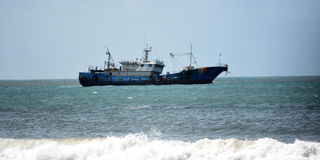
Chinese fishing boats tied to fishing trawlers at Malindi Beach in Kilifi County in this photo taken on July 19, 2021.
| Kevin Odit | Nation Media GroupNews
Premium
Foreign vessels having a field day in Kenyan waters
What you need to know:
- For the past eight months, the government has been unable to monitor and intercept foreign vessels fishing in its territorial waters in the Indian Ocean, after failing to pay Sh16 million in subscription fees for surveillance.
Just who is fishing in Kenyan waters at the coast?
This has been the question on Kenyan fishermen’s minds, as they complain about trawler and foreign vessels on the country’s coastline, depleting stocks and leaving them impoverished.
This is even as it emerged that for the past eight months, the government has been unable to monitor and intercept foreign vessels fishing in its territorial waters in the Indian Ocean, after failing to pay Sh16 million in subscription fees for surveillance.
The Vessel Monitoring System (VMS) programme was operated by Collecte Localisation Satellites (CLS), a French company that has been providing satellite data to Kenya for years.
CLS says it is a pioneer provider of monitoring and surveillance solutions. It says on its website that it is an exclusive provider of Argos environmental data.
The company works in sustainable fisheries management, environmental monitoring, maritime surveillance, fleet management and energy and mining. It processes environmental data and positions from 80,000 beacons a month, and ocean and inland water observations. It also monitors land and sea activities by satellite.

A Chinese fishing boat is pictured in Malindi, Kilifi County, on July 19, 2021.
Licensing secrecy
Kenya’s foreign fishing licensing has always been shrouded in secrecy, with efforts by the Nation to get a look at the number of vessels permitted by the government into the fishing zone thwarted several times by the Fisheries department and senior maritime officials.
Between May and August 1, 2021, the Nation, through the Global Fish Watch tracker site managed to compile more than 230 fishing vessels within its waters undertaking deep sea fishing. Most of these vessels are foreign-owned, with China, Seychelles, Italy, Taiwan, and Hong Kong-flagged vessels, appearing multiple times on the tracking site, recording more than 50,000 fishing hours within Kenyan waters.
Foreign vessels are permitted to fish within the Kenyan waters after acquiring the necessary licences through the Fisheries department.
Maritime PS Nancy Karigithu declined to comment on the number foreign fishing vessel licences issued by the Fisheries department.
“The fishing licences are the preserve of the State Department for Fisheries and Blue Economy,” Ms Karigithu said in an email response.
Kenya Maritime Authority (KMA) director general Robert Njue also declined to respond to the Nation questions.
In 2020, seven Kenyan-flagged Chinese-owned, and operated fishing vessels were authorised by the Indian Ocean Tuna Commission to fish in the Indian Ocean as from January 1, 2021, to December 31, 2031.
From the tracked vessels, Seamar li, was one of two Kenyan-flagged vessels fitted with drifting longline gear type and spotted in the Mombasa and Kilifi areas. Some of the other vessels spotted included Luweiyuanyu388, a Chinese-flagged ship, also with drifting longline gear type that was fishing in the Kilifi and Watamu.
Other fishing vessels observed within the Kenyan waters included the Chinese Taipei-flagged Hung Sheng 212 and Hsiang Fa 25, which is registered in Seychelles. The ships were off the coast of Kwale, jointly undertaking fishing at sea over the same period. Seychelles registered NF Expert Tuna, and Luqingyuangyu115 and Luweiyuanyu, both Chinese-registered were also spotted in Kwale.
Italian-flagged Angelo Padre, El Grinta, Barracuda 1, Monteray, and Paolo Primo were just some of the trawlers that were spotted within Tana River Kipini areas by fishermen. These vessels also ventured northwards towards Lamu and Kilifi.
Limited technology
According to the Fisheries department, Kenya’s marine capture fishery is composed of artisanal, semi-industrial and industrial fisheries, with the artisanal fishing fleet landing about 9,000 million tonnes of fish against a potential of about 154,000 million tonnes of tuna and other commercial fish.
“The artisanal fishermen have limited fishing technology for semi-industrial and industrial fisheries in deep waters, which are currently exploited by foreign industrial fishing vessels,” says the Fisheries department.
Now it is emerging that because of a financial crunch at the Fisheries, Monitoring, Control and Surveillance Centre at the Kenya Coast Guard Service (KCGS) in Mombasa, Kenya cannot monitor its waters in the exclusive economic zone, leaving its resources open to exploitation by foreigners.
“The VMS is not operational because of (an unpaid) Sh16 million subscription fee for maintenance,” revealed the National Assembly Committee on Agriculture.
However, committee chairperson Silas Tiren said it will ensure money is provided to the centre for the crucial monitoring.
Kenya has only one vessel, the MV Doria, used by the coast guard in monitoring the country’s territory along the Indian Ocean. It was commissioned by President Uhuru Kenyatta in Mombasa in 2018.
Kenya has been monitoring its waters using VMS and the Doria, as well as with assistance from other countries. But with the system failing and a lack of funds to operate the MV Doria, the country relies on other countries for the monitoring.
Mvita MP Abdulswamad Nassir said lawmakers were informed by fisheries officials at the centre that the system had not been operational since November last year.
“Kenya is now relying on neighbouring countries like the Seychelles to relay data on the surveillance and monitoring. They said they were not allocated any funds. The MV Doria is expensive. It costs Sh1 million a day to move the ship. So, we only rely on foreign countries,” said Mr Nassir, who raised concern about the matter because his sub-county has many fishermen.
He advised the agencies to collaborate with the Kenya Ports Authority (KPA), KMA, and other government institutions to monitor Kenyan waters.
Mr Tiren said MPs visited the centre to ascertain whether the system was monitoring all vessels in Kenyan territorial waters.
“That is why we are raising concerns (that) they are facing financial challenges, yet we have been allocating funds. We want all vessels to be monitored, whether licensed or unlicensed,” insisted Mr Tiren, who met officials at the Fisheries, Monitoring, Control and Surveillance Centre.
The committee and officials from Fisheries were on a five-day fact-finding mission in the Coast region. The lawmakers said they will protect farmers and fisherfolk.
“We are here on oversight, to look into the loopholes and improve on the challenges. We have very good laws managing the fisheries industry. We will enforce the regulations,” Mr Tiren said.
“We want to know our capacity to survey within our territory. But our monitoring is challenged. This is very bad. Treasury must provide funds to ensure we monitor our waters.”

Fish dealers store stock at the Mtwapa Beach Management Unit in Kilifi County in this photo taken on June 25, 2021. Fishermen have decried reduced stock after invasions in the Indian Ocean by Chinese fishermen.
Equipment out of service
A member of the committee, Dr John Mutunga (Tigania West), said the committee learned that the monitoring equipment is out of service due to a lack of regular payments.
“The laboratory also requires a lot of reagents, which need to be bought. This is a serious facility, yet it is not giving the country the service that was intended,” Dr Mutunga said.
And even though the system was down, he said, there is some surveillance mechanism.
“This is through collaborative efforts between different institutions like the Kenya Maritime Authority, which relay information of any strange vessel within our territory,” he said.
Once KMA officials notice a strange vessel in Kenya’s territory, they alert different agencies charged with protecting Kenya’s waters.
“The vessels must declare their intentions. If it’s a fishing vessel, they are required to pay a licensing fee and surrender a third of their catch to Kenya,” he said.
Without surveillance, the committee warned, Kenya might be losing its fish to foreign trawlers.
“But different countries are collaborating on international monitoring and when the vessels cross the borders they alert Kenya. This assists the country in knowing when there is an invasion of such vessels,” he said.
The lawmakers said they did not know the number of vessels licensed to fish in Kenya’s waters.
Kenya has a coastline of 680 kilometres from Vanga in Kwale to Kiunga in Lamu, with a seawater area of 244,800km², comprising 14,700km² of territorial water, and 230,112 km2 of Exclusive Economic Zone (EEZ).
The Fisheries department says that the northern parts of the EEZ are part of Somalia currents upwelling and rich tuna fishery grounds in the Southwest Indian Ocean.
“The potential of the territorial waters is estimated at 17,000 tonnes and the EEZ at 154,000 tonnes,” it says.
This story is part of a Nation.Africa reporting series on the state of the fishing sector at the Coast region. Also read:






